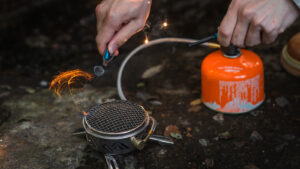
what is a canister stove?
Stoves can be classed according to the fuel they utilize. Canister stoves run on a small metal canister filled with butane or isobutane. They’re similar to the canister on your home BBQ, but considerably smaller and lighter. They are compact, lightweight, and easy to operate. Attach a stove to the canister, ignite it, and you’re good to go.
Pros to a canister stove
- Easy ignite – Canister stoves are simple to light. Turn it on, place a match or lighter beside it, and you are done.
- Lightweight – Many canister stoves are compact and connect directly to the canister. Some remotes are bigger and have gasoline lines to the canister. Remote implies there is a fuel line from the stove to the canister, but the canister does not screw into the top. Remote stoves are more steady but larger.
- No spills – The self-sealing opening prevents anything from spilling out of the canister. There’s no mess.
- Better simmer control – Many canister stoves include a wonderful control that allows you to fine-tune how much comes out. If you have to boil anything,
Cons to a canister stove
- Doesn’t work well in cold weather – Canister stoves rely on butane to produce vapor when it is released. Cold temperature complicates matters; therefore, they do not function effectively in cold weather or under low pressure. Some modern stoves are attempting to address this by installing a fuel line to the canister that is maintained upside-down, which alleviates some of the pressure concerns.
- More expensive in the long run – Canisters cannot be refuelled; hence they must be disposed of. This is one of the reasons why buying new canisters every time is more expensive than purchasing liquid gasoline.
- Hard to tell how much you have left – You can’t open up a canister unless you are throwing it out so there’s no way to see how much is left inside. There are ways to float them in water to see how high it floats to measure what’s left. Some of the newer canisters are even coming with measurements on the side to do this easier.
- Less pressure as you use them – The pressure within the canister will decrease as you use it. There is no way to pump it back up. As the canister empties, your stove will gradually lose its strength. Some modern stoves use pressure regulators to maintain the same pressure throughout the canister.
- No windscreen unless it’s remote – A windshield surrounding the stove prevents heat from being blown out the sides. If you install a windshield around a burner that attaches directly to the canister, you risk blowing yourself up. Things heat up, and when gasoline gets hot, you know what happens. If the stove has a fuel line that separates it from the canister, you can place a screen around it.
Canister Stoves: Integrated vs. Non-Integrated
If you choose a canister stove, your next choice is between an integrated and non-integrated arrangement. An integrated stove is a complete system that includes a burner, heat exchanger, and pot, whereas a non-integrated stove is separate from the cook set. In general, we prefer integrated stoves for boiling water (excellent for dry meals), while non-integrated stoves provide more culinary variety (perfect for the gourmet camp chef). Integrated types are without a doubt the most efficient canister stoves since their compact and intelligent designs effectively transmit heat and keep the wind out.
As a result, they have the quickest boil times of any other type of burner on the market. However, integrated units are often larger, heavier, and more costly than non-integrated stoves. Furthermore, they are primarily used for boiling water, are rarely compatible with other pots and pans, and lack simmering capabilities. Non-integrated stoves, on the other hand, provide great versatility by allowing for the use of a wide range of pots and pans, as well as superior flame control. They are also less expensive, lighter, and more portable than integrated systems (although you will still need a cook set). The disadvantages of non-integrated stoves are that they are more exposed to the elements (it is recommended to cook with a windshield) and are less efficient or simple to operate. However, these disadvantages are well worth it for ounce-counting minimalists or wilderness cooks searching for the most adaptability in their cook system.
Usage tips for canister stoves
- New fuel canisters typically have a little quantity of air around the top; as these flows out, the fuel will flow and burn. If the stove tips, a big yellow flame-up may appear.
- In cold weather, keep the canister warm by storing it in your sleeping bag at night or carrying it in your duffel bag or jacket pocket. Warmth helps to keep the pressure up.
- A stove with a pressure regulator will burn more effectively at higher elevations, allowing you to save fuel.
- When cooking on snow, insert a piece of foam beneath the canister to provide insulation; otherwise, a chunk of ice will freeze to the bottom.
- Most canisters have a Lindal valve with standard threading. This enables gasoline canisters to be interchangeable among brands. You’ll note, however, that manufacturers like to encourage using their brand of fuel with their stoves.
- Recycling:
- Some areas enable you to recycle used gasoline canisters. (Previously, they were frequently deemed hazardous garbage.) Check with your local recycler to ensure they accept them.











